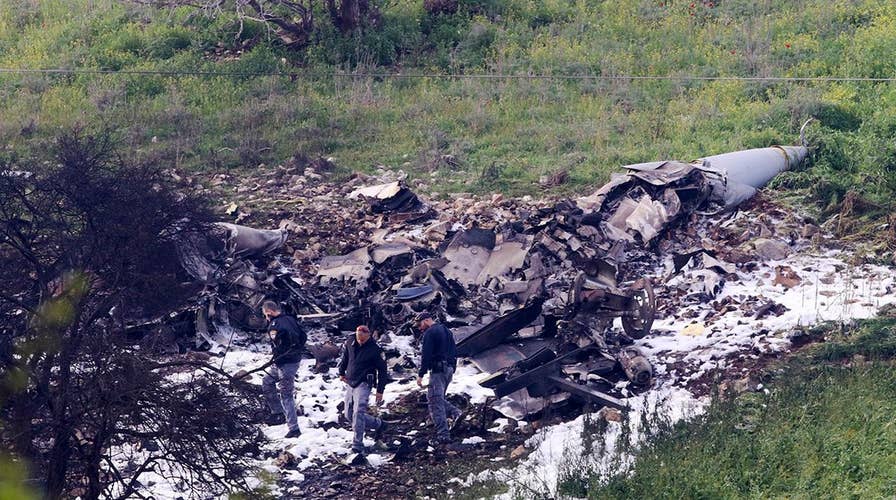Israel says Iranian drone infiltrated country
David Lee Miller reports on conflict between the countries.
The Iranian drone launched from Syria that violated Israeli air space this past weekend sent an unmistakable message to the Jewish state: Iran has opened a new front on Israel’s northern border that could eventually erupt into war.
A war with Israel does not appear imminent. Tens of thousands of Iranian-backed and battle-hardened Shiite militia fighters in Syria have their hands full now, trying to crush rebels seeking to overthrow Syrian dictator Bashar Assad.
But the militias – now serving in Syria under the command of Iran’s Islamic Revolutionary Guard Corps – are like a ticking time bomb to Israel’s north. Hailing from across the Muslim world, these forces amount to an Iranian foreign legion.
The Shiite fighters, who are stockpiling rockets and drones in Syria, have made clear that their ultimate goal is to make war on Israel. Their militias are modeled after Hezbollah, the Iranian-backed Lebanese Shiite political party, militia and terrorist group that last fought a bloody 34-day war against Israel in 2006.
Hezbollah, which is one of the militias fighting in support of Assad, boasts it has an arsenal of 150,000 rockets ready to rain down indiscriminately on Israeli cities in the event of another war. Should such a conflict break out, the Iranian foreign legion now in Syria could help to blunt an Israeli counterattack.
To deal with the threat of yet another war in the volatile Middle East, the most important step the U.S. can take right now is to designate all of the militia groups fighting on behalf of Assad as terrorist organizations. Only after recognizing this threat for what it is will the U.S. and our allies be able to begin to formulating a strategy and take decisive action.
It took years for the Shiite militias to become a major force in Syria. When Assad’s army began to break down during the first years of his war against internal opponents, Iran sought to reinforce his regime by organizing local defense forces and importing fighters from abroad.
The locals were often prepared to defend their hometowns, but Iran understood that it also needed a substantial body of men ready to fight anywhere and suffer heavy casualties.
Already, Iran controlled one intensely committed and ideologically motivated force – Hezbollah. But even though Hezbollah maintains an estimated 7,000 fighters in Syria, this number is far from enough to keep Assad in power. Thus Iran has turned to other groups that its Revolutionary Guard has created in Hezbollah’s image.
According to Persian-language sources, the largest foreign formation in Syria is the Fatemiyoun Division, which consists of 12,000 to 14,000 Afghan Shiites, drawn mainly from the 3 million Afghan migrants living in Iran.
The real number of Afghan fighters may only be half of what’s claimed, yet this fact only underscores their high fatality rates – there have already been more than 840 documented funerals of Afghan fighters in Syria. Iranian Supreme Leader Ayatollah Ali Khamenei has met publicly with the families of the fallen.
The Afghan fighters have said they are prepared fight on – and not just in Syria. According to a November statement celebrating the defeat of ISIS, the men of the Fatemiyoun “have sworn that they will not sit down until the elimination of the international Zionism.”
Also hailing from South Asia are the Pakistani Shiites of the Zeynabioun Brigade. Although one of their commanders claims that his fighters number in the thousands, there may be less than 1,000 in Syria at any one time. Like its Afghan counterpart, the Zeynabioun Brigade heralded the fall of the ISIS caliphate by pledging its readiness to fight anywhere the Revolutionary Guard sends it.
With its Shiite majority, Iraq has been another plentiful source of manpower for Iran’s Revolutionary Guard. The most potent Iraqi militias fought against U.S. troops after the fall of Iraqi dictator Saddam Hussein, killing and wounding hundreds of Americans.
Many Iraqis returned home from Syria in 2014 to fight ISIS in Iraq. The defeat of ISIS has made these Iraqi fighters available once again to fight in Syria – or perhaps a future war against Israel.
Kataib Hezbollah is the only Iraqi Shiite militia with the distinction of being designated as a foreign terrorist organization by the U.S. State Department. Equally deserving is Asaib Ahl al Haq, which proudly reports that it conducted 6,000 attacks on U.S. troops prior to their withdrawal from Iraq in 2011.
Human rights monitors have reported that both groups are responsible for massacres of Sunni Arabs in Iraq. In addition to deploying thousands of their own fighters to Syria, Kataib Hezbollah and Asaib Ahl al Haq have also helped to establish other Iranian-backed militias, such as Kataib Imam Ali and Harakat Hezbollah al Nujaba.
The ideological fervor of the Iraqi fighters runs deep. The leader of Nujaba, the U.S.-designated terrorist Akram al-Kabi, announced in 2015 that he would overthrow the Iraqi government if ordered to do so by Ayatollah Khamenei. Ambitiously, Nujaba has already created a “Golan Liberation Brigade” to reclaim Syrian territory lost to Israel in the Six Day War.
While Syrian Shiites have yet to fight abroad on behalf of Tehran, some of their militias profess the same commitment as their Iraqi counterparts. The leaders of one such group, the Sayyida Ruqayya Brigade, explain in an Iranian documentary that their real enemy is Israel.
Ruqayya and other groups, such as the Baqir Brigade and Al Rida Forces, are not shy about their connections to Lebanese Hezbollah and support for its agenda.
Together, these fighters at war in Syria today pose a danger to Israel in the future that neither Israel nor the United States can ignore.

